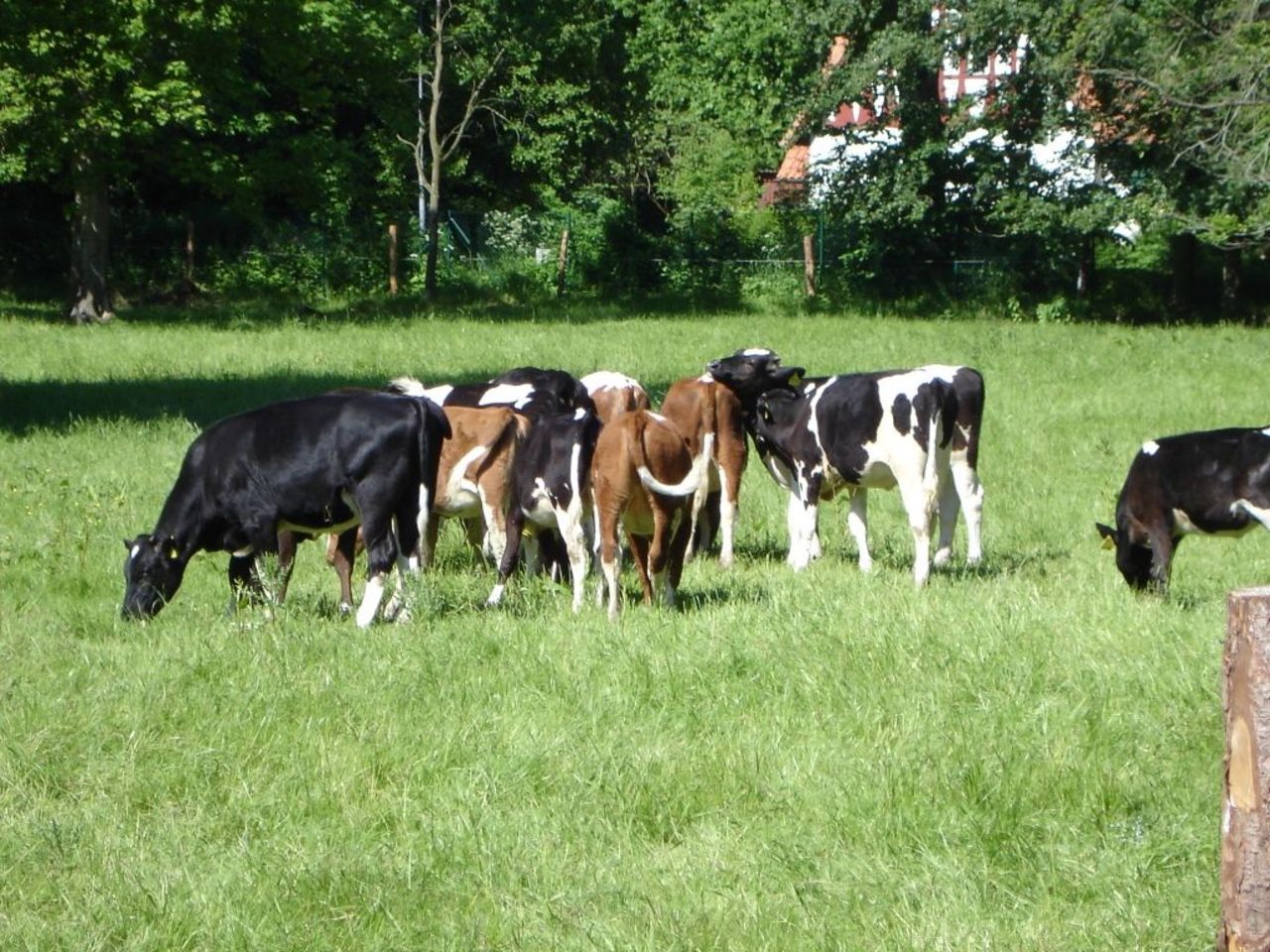Project
Decision Trees for Deworming

Control of Endoparasites of Ruminants in Organic Farming by internet-based Decision Tree
Control of gastrointestinal worms of grazing ruminants is crucial to animal health and farmer’s economic success. At the same time the smallest possible amount of drugs is to be used.
Background and Objective
Grazing on pasture is the most appropriate husbandry system for ruminants. But all ruminants with access to pasture are exposed to gastrointestinal parasites. In the course of foresighted animal health care it must be prevented:
•that parasitic disease occurs.
•that lower performance reduces the economic success of the farmer.
•that pastures get that much contaminated with parasite eggs that subsequent grazing is only possible if a large amount of pharmaceuticals get administered.
•that an unnecessary amount of medicine is applied.
Furthermore, only the epidemiological optimal deworming agent with the less harm to nature should be used and the farmer should only treat the animals in need to get dewormed at the right moment. This aids environmental protection and also serves to delay the spread of anthelmintic resistance in worm populations.
Pasture for all ruminants is an important point in sustainable husbandry and animal welfare. In the consumer's perception of animal welfare grazing has a central role. At the same time more grazing for the animals means more opportunities to become infected and ill. This problem is particularly relevant in case of parasitic infections.
But skillful planning of pasture management can often meet the two demands. Within the operating plan for the management of pastures the farmer can match measures that are important for parasite prophylaxis (e.g. provide surfaces that do not contain worm larvae at turn out) together with other aspects of management (e.g. the time of mowing). However, the cost of this planning and the sustainable parasite control must be visibly worthwhile for the farmer.
Therefore a management tool should be created to represent scientific knowledge about the somewhat complicated parasite problems in a way that the farmer has the option to involve parasite prophylaxis at the beginning of his pasture planning. In addition, suggestions for sustainable parasite control and efficient medication should be offered.
Approach
For this task, a decision tree has been proven to be suitable. For young cattle in intensive production in the Netherlands a decision tree is already online for several years (www.parasietenwijzer.nl). The recommendations correspond to the state of knowledge and are drawn up together with the Utrecht University, Faculty of Veterinary Medicine.
Data and Methods
The decision trees are built in cooperation with the IT department of the Thuenen-Institute of following the Dutch pattern, using yED-Graph Editor® and TYPO3 software.
Results
During the last years four decision trees have been built in German language, one for first season cattle in intensive dairy husbandry, one for young cattle in suckling-cow management and two for lambs in intensive sheep and goat husbandry, respectively.
At “www.weide-parasiten.de” these decision trees are free to access.
Questions about the pasturage of ruminants (capital letters in the navigation scheme), that need to be answered with Yes / No, make you navigate through the decision tree. After passing through the navigation scheme you will end up at one recommendation (digits in the navigation scheme), which initially has the safety of the animals in focus.
Depending on the answers, the farmer will get the recommendation to wait and watch his animals carefully, to monitor the egg count of the herd or to treat with long acting or short acting anthelmintic drug.
German law does not allow mentioning pharmaceuticals by user's name. But if you click at "Anthelminthika" you will find a list of allowed pharmacologically active substances. All of them need a veterinarian prescription. The European regulations on organic farming let anthelmintic treatments explicitly free of restriction in the number of treatments. However, the withdrawal periods have always to be doubled. In EC substances which have no registration and no value for their “Maximal Residue Limit” in meat, milk or eggs, are not allowed to be used in production animals. This concerns as well phytotherapeuticals or other alternatives in use for deworming. Therefore these are not mentioned in the decision trees.
By trial and error the farmer can follow the various paths through the navigation scheme of the decision trees. He can make out which pasture conditions must be met in order to reduce his drug use and not to endanger the health of his animals and his economic success.
Of course, decision trees are just a tool and recommendations may sometimes be too strict to prevent disease. For instance, in cattle a threshold of 100 strongyle eggs per gram feces (EPG) in a bulk sample of the herd is used before it is sometimes advised to treat. Such a threshold may be too conservative. But it has to keep in mind that such thresholds are set as well to prevent too much contamination of pasture with worm larvae, thereby keeping pastures relatively safe for grazing by animals. Another problem of the decision tree may be the search for a laboratory which is able and willing to count eggs (McMaster method) instead of using more qualitative techniques to check samples for worm eggs. Together with other questions a following project (Modell- und Demonstrationsvorhaben) will evaluate these problems.
In addition to the decision trees the website offers various biological and technical information about roundworms in ruminants. In the coming years, the pages will be updated regularly. Through communication with users and professionals we want to improve the site constantly.
Ultimately, we hope that a suitable pasture will be offered to all ruminants, even to young animals, although they are particularly susceptible to worms.By foresighted pasture measures, regular monitoring for worm eggs in feces, supplemented by targeted deworming if necessary, gastrointestinal parasites are manageable.
Links and Downloads
Involved external Thünen-Partners
-
Universität Utrecht
(Utrecht, Niederlande)
Funding Body
-
Federal Ministry of Food und Agriculture (BMEL)
(national, öffentlich)
Duration
11.2009 - 9.2011
More Information
Project funding number: 08OE162
Funding program: Bundesprogramm Ökologischer Landbau und andere Formen nachhaltiger Landwirtschaft (BÖLN)
Project status:
finished
Publications
- 0
Koopmann R, Kühne S (2017) Entwurmungsmittel im Dung - ein Risiko für Nicht-Ziel-Organismen. Tierärztl Umsch 72(10):392-395
- 1
Koopmann R, Kühne S (2017) Tierarzneimittel (Antiparasitika) im Kuhfladen - Ein Risiko für Nicht-Ziel-Organismen (Literaturübersicht). Landbauforsch Appl Agric Forestry Res 67(2):70-92, DOI:10.3220/LBF1501500814000
- 2
Koopmann R (2015) Ein Weg zur gezielten Entwurmung bei Ziegen. Forschungsrep Spezial Ökol Landbau:20-21
- 3
Koopmann R, Dämmrich M, Ploeger H (2014) Online decision trees to support the control of gastrointestinal worms in ruminants. Thünen Rep 20, Vol. 2:331-334
- 4
Koopmann R, March S, Brinkmann J (2014) Parasitenprophylaxe durch Weidemanagement - Entscheidungsbäume können helfen. Tierärztl Umsch 69(4):107-111
- 5
Koopmann R, Dämmrich M, Ploeger H (2013) Entscheidungsbaum zur vorausschauenden Bekämpfung von Magen-Darm Würmern bei Wiederkäuern. In: Neuhoff D, Stumm C, Ziegler S, Rahmann G, Hamm U, Köpke U (eds) Beiträge zur 12. Wissenschaftstagung Ökologischer Landbau : Ideal und Wirklichkeit: Perspektiven ökologischer Landbewirtschaftung . Berlin: Köster, pp 474-475
- 6
Koopmann R (2013) Hilfe bei Weideparasiten. Wochenbl Magazin Baden Württemberg(2):23
- 7
Koopmann R, Dämmrich M, Ploeger H (2013) Weidegang ohne Risiko : neue Wege zur Kontrolle von Darmparasiten bei Wiederkäuern. Forschungsrep Spezial Ökol Landbau 2013:12-13
- 8
Dämmrich M, Ploeger H, Koopmann R (2011) Parasitenkontrolle und Weidemanagement mithilfe eines interaktiven Entscheidungsbaumes am Beispiel der Magen-Darm-Strongyliden bei Rindern in Norddeutschland. In: Leithold G, Becker K, Brock C (eds) Beiträge zur 11. Wissenschaftstagung Ökologischer Landbau : Es geht ums Ganze: Forschen im Dialog von Wissenschaft und Praxis : Bd. 2, Tierproduktion und Sozioökonomie. Berlin: Köster, pp 68-69

![[Translate to English:] [Translate to English:]](/media/_processed_/8/e/csm_Bildschirmfoto_2021-03-03_bearb_fc48ac88bf.jpeg)
![[Translate to English:] [Translate to English:]](/media/_processed_/8/e/csm_Bildschirmfoto_2021-03-03_bearb_ba3ec0e9d7.jpeg)

![[Translate to English:] Logo des Bundesministerium für Ernährung und Landwirtschaft](/media/allgemein/logos/BMEL_Logo.svg)